Abstract
Antigen HLA-B27 is a high-risk genetic factor with respect to a group of rheumatoid disorders, especially ankylosing spondylitis. A cDNA library was constructed from an autozygous B-cell line expressing HLA-B27, HLA-Cw1, and the previously cloned HLA-A2 antigen. Clones detected with an HLA probe were isolated and sorted into homology groups by differential hybridization and restriction maps. Nucleotide sequencing allowed the unambiguous assignment of cDNAs to HLA-A, -B, and -C loci. The HLA-B27 mRNA has the structural features and the codon variability typical of an HLA class I transcript but it specifies two uncommon amino acid replacements: a cysteine in position 67 and a serine in position 131. The latter substitution may have functional consequences, because it occurs in a conserved region and at a position invariably occupied by a species-specific arginine in humans and lysine in mice. The availability of the complete sequence of HLA-B27 and of the partial sequence of HLA-Cw1 allows the recognition of locus-specific sequence markers, particularly, but not exclusively, in the transmembrane and cytoplasmic domains.
Full text
PDF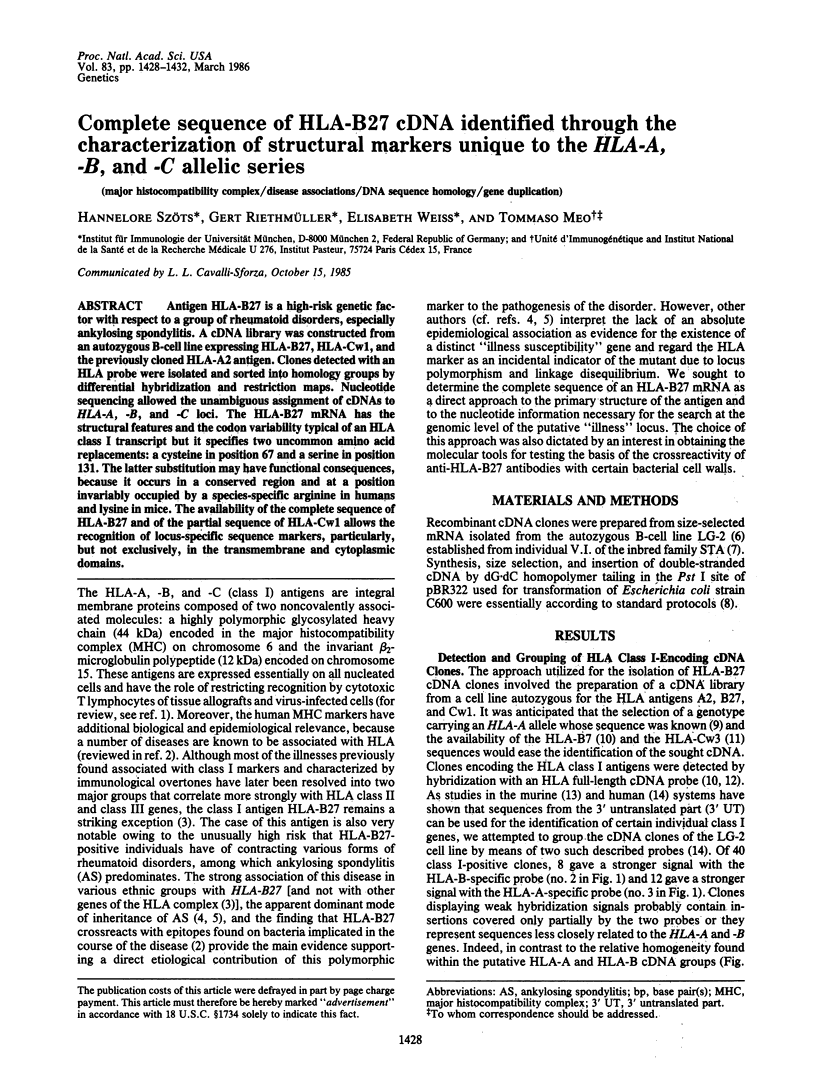
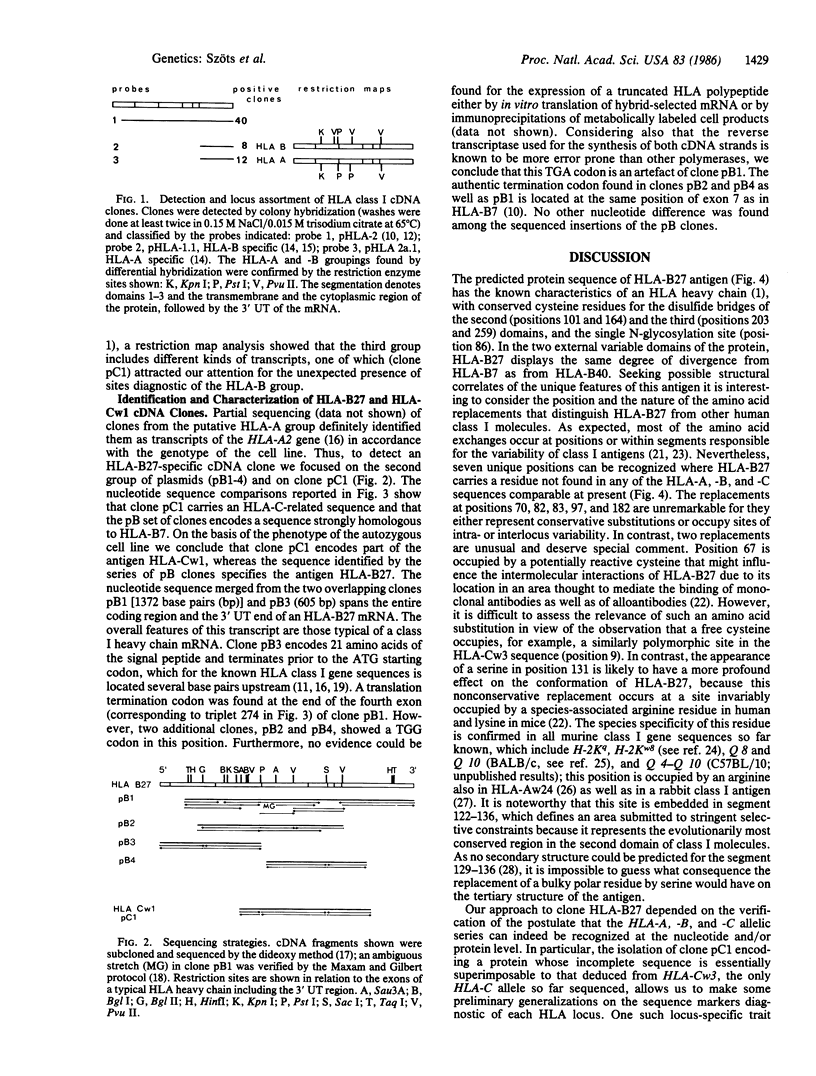
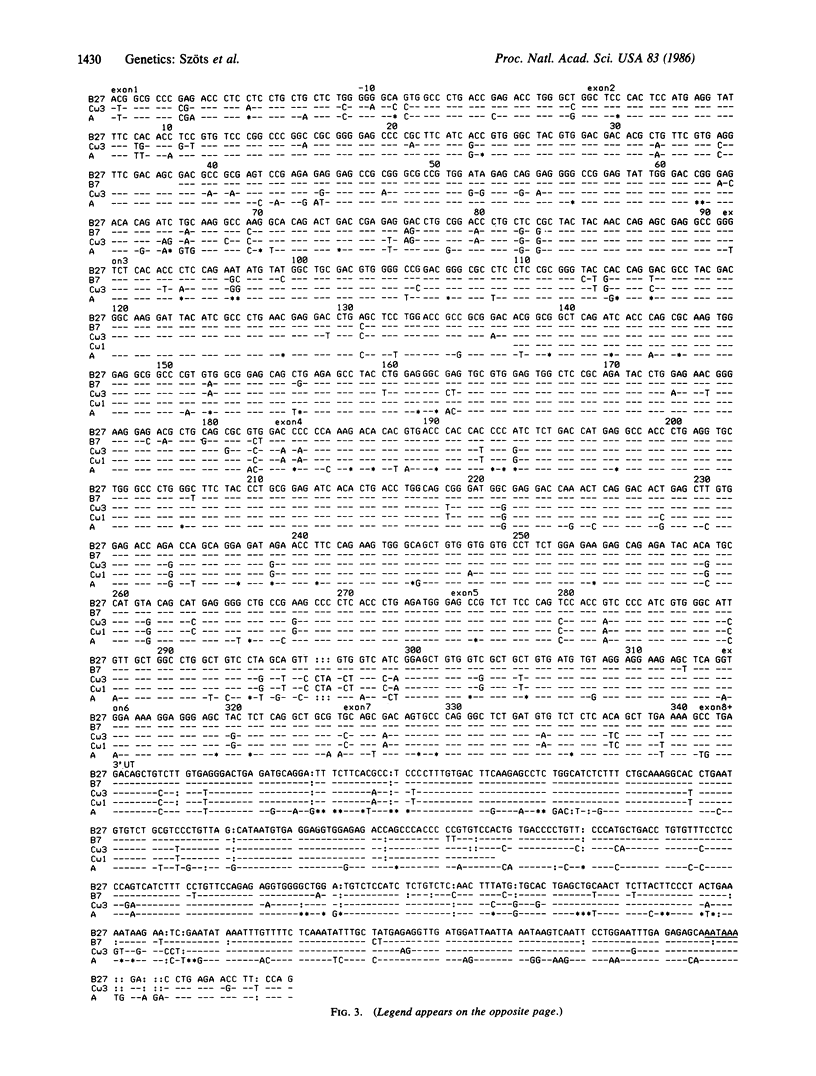
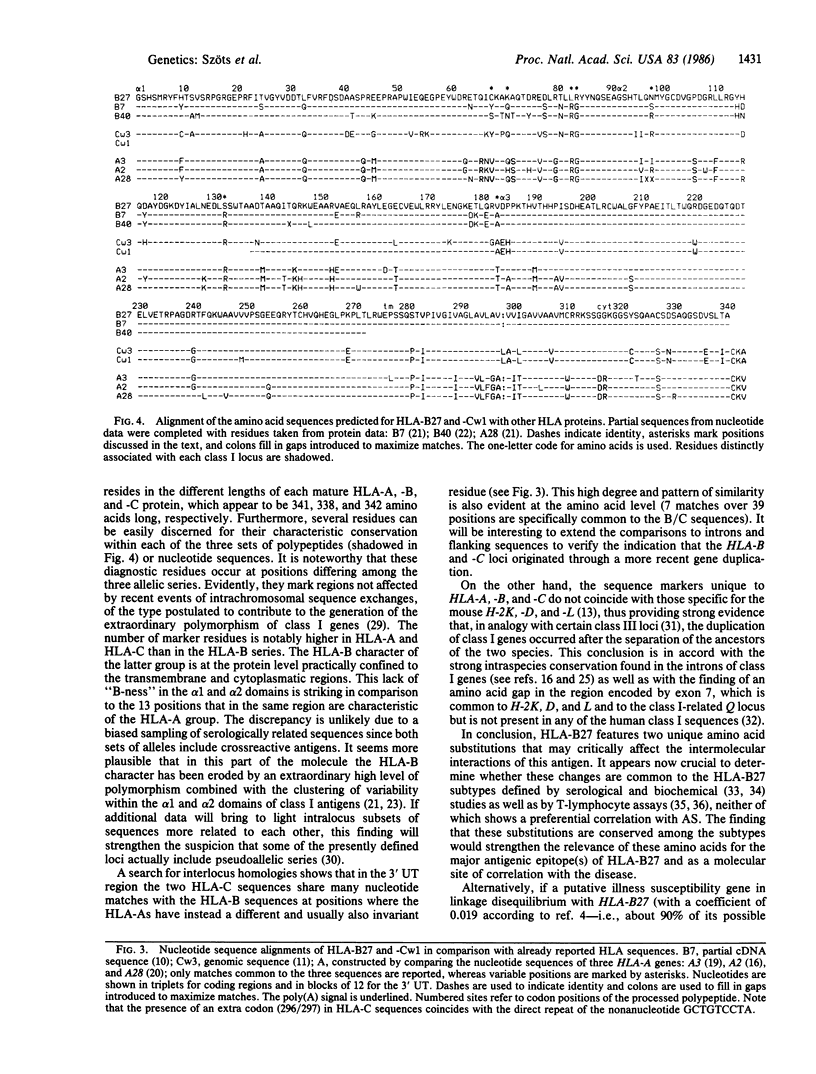
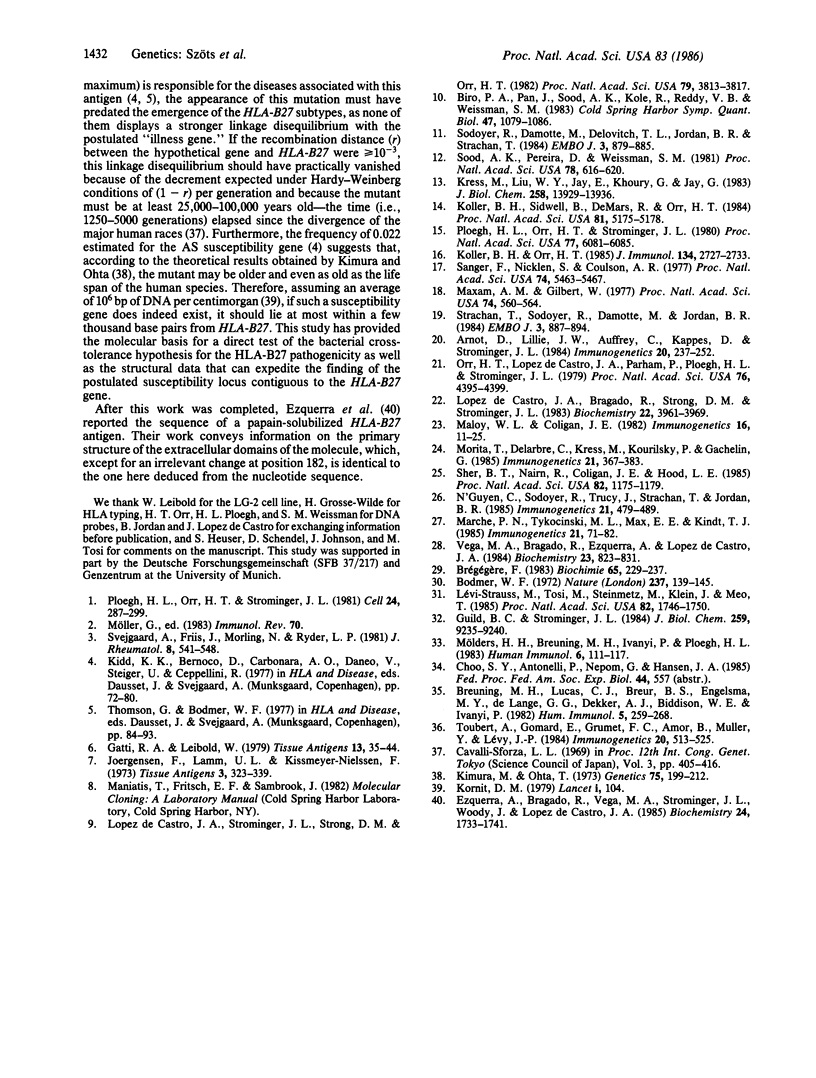
Images in this article
Selected References
These references are in PubMed. This may not be the complete list of references from this article.
- Arnot D., Lillie J. W., Auffray C., Kappes D., Strominger J. L. Inter-locus and intra-allelic polymorphisms of HLA class I antigen gene mRNA. Immunogenetics. 1984;20(3):237–252. doi: 10.1007/BF00364206. [DOI] [PubMed] [Google Scholar]
- Bodmer W. F. Evolutionary significance of the HL-A system. Nature. 1972 May 19;237(5351):139–passim. doi: 10.1038/237139a0. [DOI] [PubMed] [Google Scholar]
- Breuning M. H., Lucas C. J., Breur B. S., Engelsma M. Y., de Lange G. G., Dekker A. J., Biddison W. E., Ivanyi P. Subtypes of HLA-B27 detected by cytotoxic T lymphocytes and their role in self-recognition. Hum Immunol. 1982 Dec;5(4):259–268. doi: 10.1016/0198-8859(82)90018-0. [DOI] [PubMed] [Google Scholar]
- Brégégère F. A directional process of gene conversion is expected to yield dynamic polymorphism associated with stability of alternative alleles in class I histocompatibility antigens gene family. Biochimie. 1983 Apr-May;65(4-5):229–237. doi: 10.1016/s0300-9084(83)80274-0. [DOI] [PubMed] [Google Scholar]
- Ezquerra A., Bragado R., Vega M. A., Strominger J. L., Woody J., López de Castro J. A. Primary structure of papain-solubilized human histocompatibility antigen HLA-B27. Biochemistry. 1985 Mar 26;24(7):1733–1741. doi: 10.1021/bi00328a025. [DOI] [PubMed] [Google Scholar]
- Fukumaki Y., Collins F., Kole R., Stoeckert C. J., Jr, Jagadeeswaran P., Duncan C. H., Weissman S. M., Jagadeeswaran P., Pan J., Forget B. G. Sequences of human repetitive DNA, non-alpha-globin genes, and major histocompatibility locus genes. Cold Spring Harb Symp Quant Biol. 1983;47(Pt 2):1079–1086. [PubMed] [Google Scholar]
- Gatti R. A., Leibold W. HLA--D typing with lymphoblastoid cell lines. IV. Allelic relationships. Tissue Antigens. 1979 Jan;13(1):35–44. doi: 10.1111/j.1399-0039.1979.tb01134.x. [DOI] [PubMed] [Google Scholar]
- Guild B. C., Strominger J. L. Human and murine class I MHC antigens share conserved serine 335, the site of HLA phosphorylation in vivo. J Biol Chem. 1984 Jul 25;259(14):9235–9240. [PubMed] [Google Scholar]
- Jorgensen F., Lamm L. U., Kissmeyer-Nielsen F. Mixed lymphocyte cultures with inbred individuals: an approach to MLC typing. Tissue Antigens. 1973;3(4):323–329. doi: 10.1111/j.1399-0039.1973.tb01010.x. [DOI] [PubMed] [Google Scholar]
- Kimura M., Ohta T. The age of a neutral mutant persisting in a finite population. Genetics. 1973 Sep;75(1):199–212. doi: 10.1093/genetics/75.1.199. [DOI] [PMC free article] [PubMed] [Google Scholar]
- Koller B. H., Orr H. T. Cloning and complete sequence of an HLA-A2 gene: analysis of two HLA-A alleles at the nucleotide level. J Immunol. 1985 Apr;134(4):2727–2733. [PubMed] [Google Scholar]
- Koller B. H., Sidwell B., DeMars R., Orr H. T. Isolation of HLA locus-specific DNA probes from the 3'-untranslated region. Proc Natl Acad Sci U S A. 1984 Aug;81(16):5175–5178. doi: 10.1073/pnas.81.16.5175. [DOI] [PMC free article] [PubMed] [Google Scholar]
- Kress M., Liu W. Y., Jay E., Khoury G., Jay G. Comparison of class I (H-2) gene sequences. Derivation of unique probes for members of this multigene family. J Biol Chem. 1983 Nov 25;258(22):13929–13936. [PubMed] [Google Scholar]
- Levi-Strauss M., Tosi M., Steinmetz M., Klein J., Meo T. Multiple duplications of complement C4 gene correlate with H-2-controlled testosterone-independent expression of its sex-limited isoform, C4-Slp. Proc Natl Acad Sci U S A. 1985 Mar;82(6):1746–1750. doi: 10.1073/pnas.82.6.1746. [DOI] [PMC free article] [PubMed] [Google Scholar]
- López de Castro J. A., Strominger J. L., Strong D. M., Orr H. T. Structure of crossreactive human histocompatibility antigens HLA-A28 and HLA-A2: possible implications for the generation of HLA polymorphism. Proc Natl Acad Sci U S A. 1982 Jun;79(12):3813–3817. doi: 10.1073/pnas.79.12.3813. [DOI] [PMC free article] [PubMed] [Google Scholar]
- López de Castro J., Bragado R., Strong D. M., Strominger J. L. Primary structure of papain-solubilized human histocompatibility antigen HLA-B40 (-Bw60). An outline of alloantigenic determinants. Biochemistry. 1983 Aug 2;22(16):3961–3969. doi: 10.1021/bi00285a036. [DOI] [PubMed] [Google Scholar]
- Maloy W. L., Coligan J. E. Primary structure of the H-2Db alloantigen. II. Additional amino acid sequence information, localization of a third site of glycosylation and evidence for K and D region specific sequences. Immunogenetics. 1982;16(1):11–22. doi: 10.1007/BF00364438. [DOI] [PubMed] [Google Scholar]
- Marche P. N., Tykocinski M. L., Max E. E., Kindt T. J. Structure of a functional rabbit class I MHC gene: similarity to human class I genes. Immunogenetics. 1985;21(1):71–82. doi: 10.1007/BF00372243. [DOI] [PubMed] [Google Scholar]
- Maxam A. M., Gilbert W. A new method for sequencing DNA. Proc Natl Acad Sci U S A. 1977 Feb;74(2):560–564. doi: 10.1073/pnas.74.2.560. [DOI] [PMC free article] [PubMed] [Google Scholar]
- Morita T., Delarbre C., Kress M., Kourilsky P., Gachelin G. An H-2K gene of the tw32 mutant at the T/t complex is a close parent of an H-2Kq gene. Immunogenetics. 1985;21(4):367–383. doi: 10.1007/BF00430802. [DOI] [PubMed] [Google Scholar]
- Mölders H. H., Breuning M. H., Ivanyi P., Ploegh H. L. Biochemical analysis of variant HLA-B27 antigens. Hum Immunol. 1983 Feb;6(2):111–117. doi: 10.1016/0198-8859(83)90067-8. [DOI] [PubMed] [Google Scholar]
- N'Guyen C., Sodoyer R., Trucy J., Strachan T., Jordan B. R. The HLA-AW24 gene: sequence, surroundings and comparison with the HLA-A2 and HLA-A3 genes. Immunogenetics. 1985;21(5):479–489. doi: 10.1007/BF00430931. [DOI] [PubMed] [Google Scholar]
- Orr H. T., Lopez de Castro J. A., Parham P., Ploegh H. L., Strominger J. L. Comparison of amino acid sequences of two human histocompatibility antigens, HLA-A2 and HLA-B7: location of putative alloantigenic sites. Proc Natl Acad Sci U S A. 1979 Sep;76(9):4395–4399. doi: 10.1073/pnas.76.9.4395. [DOI] [PMC free article] [PubMed] [Google Scholar]
- Ploegh H. L., Orr H. T., Strominger J. L. Major histocompatibility antigens: the human (HLA-A, -B, -C) and murine (H-2K, H-2D) class I molecules. Cell. 1981 May;24(2):287–299. doi: 10.1016/0092-8674(81)90318-4. [DOI] [PubMed] [Google Scholar]
- Ploegh H. L., Orr H. T., Strominger J. L. Molecular cloning of a human histocompatibility antigen cDNA fragment. Proc Natl Acad Sci U S A. 1980 Oct;77(10):6081–6085. doi: 10.1073/pnas.77.10.6081. [DOI] [PMC free article] [PubMed] [Google Scholar]
- Sanger F., Nicklen S., Coulson A. R. DNA sequencing with chain-terminating inhibitors. Proc Natl Acad Sci U S A. 1977 Dec;74(12):5463–5467. doi: 10.1073/pnas.74.12.5463. [DOI] [PMC free article] [PubMed] [Google Scholar]
- Sher B. T., Nairn R., Coligan J. E., Hood L. E. DNA sequence of the mouse H-2Dd transplantation antigen gene. Proc Natl Acad Sci U S A. 1985 Feb;82(4):1175–1179. doi: 10.1073/pnas.82.4.1175. [DOI] [PMC free article] [PubMed] [Google Scholar]
- Sodoyer R., Damotte M., Delovitch T. L., Trucy J., Jordan B. R., Strachan T. Complete nucleotide sequence of a gene encoding a functional human class I histocompatibility antigen (HLA-CW3). EMBO J. 1984 Apr;3(4):879–885. doi: 10.1002/j.1460-2075.1984.tb01900.x. [DOI] [PMC free article] [PubMed] [Google Scholar]
- Sood A. K., Pereira D., Weissman S. M. Isolation and partial nucleotide sequence of a cDNA clone for human histocompatibility antigen HLA-B by use of an oligodeoxynucleotide primer. Proc Natl Acad Sci U S A. 1981 Jan;78(1):616–620. doi: 10.1073/pnas.78.1.616. [DOI] [PMC free article] [PubMed] [Google Scholar]
- Strachan T., Sodoyer R., Damotte M., Jordan B. R. Complete nucleotide sequence of a functional class I HLA gene, HLA-A3: implications for the evolution of HLA genes. EMBO J. 1984 Apr;3(4):887–894. doi: 10.1002/j.1460-2075.1984.tb01901.x. [DOI] [PMC free article] [PubMed] [Google Scholar]
- Svejgaard A., Friis J., Morling N., Ryder L. P. HLA in rheumatology. J Rheumatol. 1981 Jul-Aug;8(4):541–546. [PubMed] [Google Scholar]
- Toubert A., Gomard E., Grumet F. C., Amor B., Muller J. Y., Levy J. P. Identification of several functional subgroups of HLA-B27 by restriction of the activity of antiviral T killer lymphocytes. Immunogenetics. 1984;20(5):513–525. doi: 10.1007/BF00364354. [DOI] [PubMed] [Google Scholar]
- Vega M. A., Bragado R., Ezquerra A., López de Castro J. A. Variability and conformation of HLA class I antigens: a predictive approach to the spatial arrangement of polymorphic regions. Biochemistry. 1984 Feb 28;23(5):823–831. doi: 10.1021/bi00300a007. [DOI] [PubMed] [Google Scholar]



